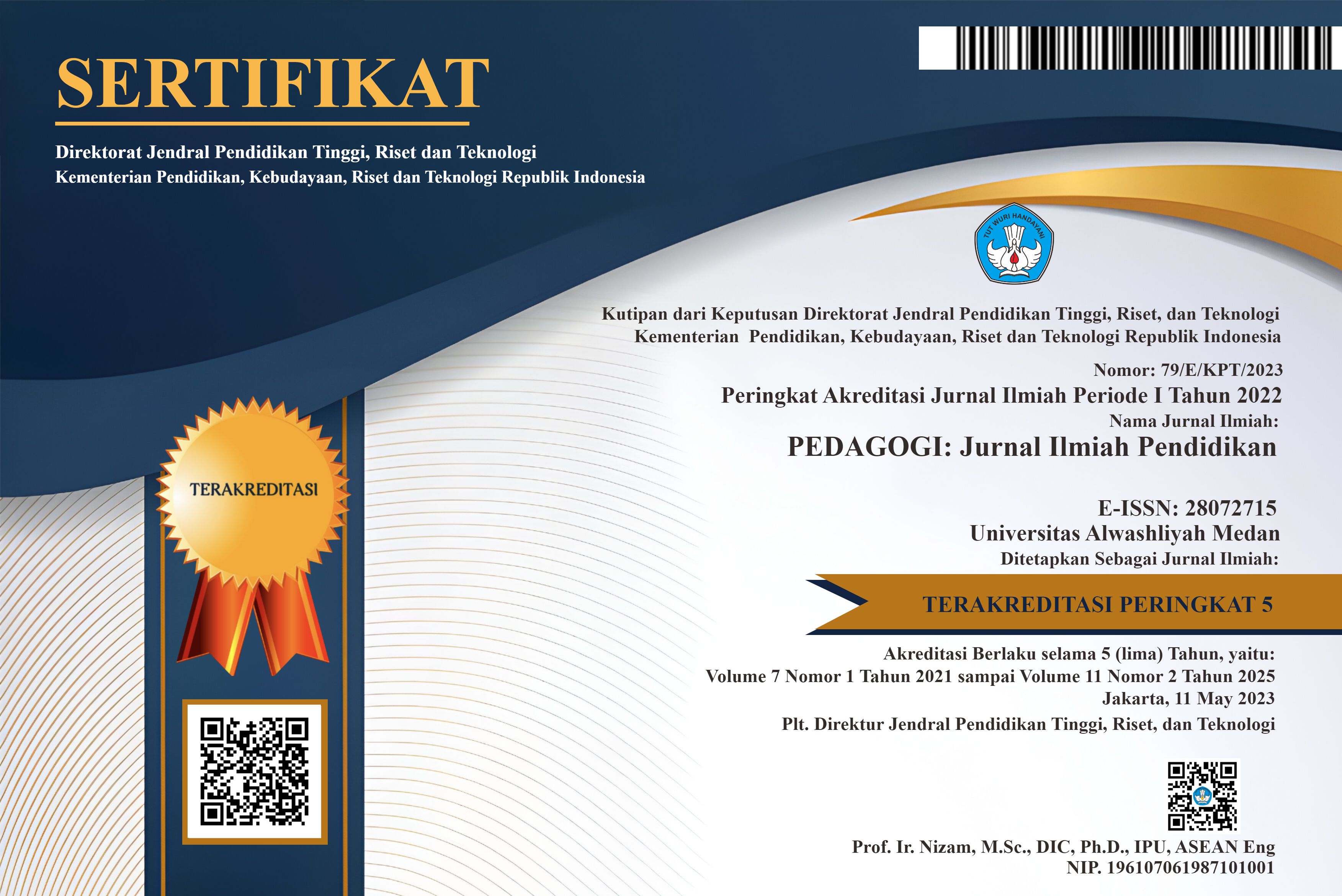METODE DEMONSTRASI DALAM PEMBELAJARAN PAI UNTUK MEMOTIVASI DAN MEMBERIKAN PEMBELAJARAN YANG BERMAKNA
DOI:
https://doi.org/10.47662/pedagogi.v11i2.1171Kata Kunci:
Demonstration Method,, PAI Learning in Elementary School,, Learning Motivation, Meaningful Learning, Internalization of Islamic Values.Abstrak
This qualitative study seeks to evaluate the implementation of the demonstration method in Islamic Religious Education (PAI) learning and analyse its impact on learning motivation and the creation of meaningful learning for students. The background of the study is motivated by the phenomenon of PAI learning, which is often textual and less involved with concrete experiences, thus potentially reducing students' interest and profound understanding. Data were collected through participant observation, in-depth interviews with teachers and students, and document analysis at SDN Pondok Ranji 03, South Tangerang City, Banten. This study involved several students and one PAI teacher as subjects. Data analysis used the Miles and Huberman thematic analysis technique. The research findings revealed that 1) the demonstration method significantly increased students' learning motivation through visualisation of worship practices (such as ablution, prayer, or Islamic history); 2) demonstrations create meaningful learning by connecting religious values with real-life contexts; and 3) supporting factors include teacher creativity, authentic media, and active student participation, while the main obstacles are time allocation and the readiness of facilities. The conclusion of the study confirms that the demonstration method has the potential as an innovative strategy in PAI to build emotional-intellectual engagement and internalisation of religious values. The implication is that educators need to design contextual and reflective demonstrations to optimise holistic Islamic religious education learning.
Referensi
Arsyad, A. (2017). Media Pembelajaran (cet. 12, Vol. 1). Rajawali Pers.
Ausubel, D. P. (1968). Educational Psychology: A Cognitive View.
Creswell, J. W., & Poth, C. N. (2018). Qualitative Inquiry and Research Design (4 ed.). Sage.
Denzin, N. K. (2017). The Research Act: A Theoretical Introduction to Sociological Methods. Routledge.
Fathurrohman, M. (2015). Model-model Pembelajaran Inovatif: Alternatif Desain Pembelajaran yang Menyenangkan. Ar-Ruzz Media.
Hamdani. (2019a). Scaffolding Inklusif untuk Pembelajaran Berdiferensiasi. Pustaka Setia.
Hamdani. (2019b). Strategi Belajar Mengajar. Pustaka Setia.
Hermawan, C. M., Hesti, Anjani, L. S., Fuadah, S. F. F., Gani, I. A., & Rosfiani, O. (2024). Utilizing the Demonstration Method to Enhance Science Learning Outcomes. EDUTREND: Journal of Emerging Issues and Trends in Education, 1(2), 92–107. https://doi.org/10.59110/edutrend.279
Ikhwan, A. (2021). Rekonstruksi Experiential Learning untuk PAI SD. Jurnal Pedagogik, 8(2), 210–225.
Kolb, D. A. (2015). Experiential Learning: Experience as the Source of Learning and Development (2 ed.). Pearson.
Kurniasih Berlin, I.-S. (2017). Ragam Pengembangan Model Pembelajaran Untuk Peningkatan Profesionalitas Guru. Kata Pena.
Kurniawan, D. (2019). Psikologi Perkembangan Anak SD. UM Press.
Kuswiyanti, T. S., Achdiyat, I. P., Rosfiani, O., Hermawan, C. M., Batrisya, A. N., & Hermawan, I. N. (2023). The Efficacy of the Direct Instruction Approach for Teaching English to Fourth-Grade Students with Ordinal Numbers (hlm. 341–348). https://doi.org/10.2991/978-2-38476-078-7_35
Majid, A. (2016). Desain Pembelajaran Inklusif SD. Remaja Rosdakarya.
Ma’ruf, M. (2021). Meaningful Learning dalam Kurikulum PAI SD. Bumi Aksara.
Moleong, L. J. (2019). Metodologi Penelitian Kualitatif (Edisi Revisi). Remaja Rosdakarya.
Morse, J. M. (1995). The Significance of Saturation. Qualitative Health Research, 5(2), 147–149. https://doi.org/10.1177/104973239500500201
Muhaimin. (2015a). Pengembangan Kurikulum Pendidikan Agama Islam di Sekolah, Madrasah, dan Perguruan Tinggi. Rajawali Pers.
Muhaimin. (2015b). Psikologi Perkembangan Religiusitas Anak. Rajawali Pers.
Mulyasa, E. (2021). Menjadi Guru Profesional Menciptakan Pembelajaran Kreatif dan Menyenangkan. Remaja Rosdakarya.
Nata, A. (2018). Perspektif Islam tentang Strategi Pembelajaran. Kencana.
Nurlaelah, E. (2018). Efektivitas Metode Inovatif dalam PAI. Jurnal Pendidikan Dasar, 5(2), 112–125.
Prasetyo, B., & Abduh, M. (2021). Metode Demonstrasi: Dampak pada Motivasi Belajar. Kencana.
Rahman, A. (2019a). E-Learning dalam Pendidikan Agama Islam. Jurnal Teknopedagogi, 5(2), 112–125.
Rahman, A. (2019b). Inovasi Pembelajaran PAI Melalui Pendekatan Kontekstual. Jurnal Pendidikan Agama Islam, 16(1), 45–62.
Rosfiani, O., Hermawan, M., Sari, R. K., & Hastuti, S. (t.t.). Improving Student Mathematics Achievements Of Elementary School In 1 st Grade Through Demonstration Models. www.ijstr.org
Rosfiani, O., Rahmadani Amiruddin, N., Qurrotul Ain, S., Andriyansyah, M., & Alfian, N. (2024). Peningkatan Hasil Belajar Membaca Bahasa Indonesia Melalui Model Pengajaran Langsung Pada Siswa Kelas I MI Ilham I Kota Jakarta Utara. Nabil Alfian Journal of Human And Education, 4(6), 1285–1296.
Ryan, R. M., & Deci, E. L. (2017). Self-Determination Theory: Basic Psychological Needs in Motivation, Development, and Wellness. Guilford Press.
Sagala, S. (2018). Konsep dan Makna Pembelajaran. Alfabeta.
Sanjaya, W. (2016). Strategi Pembelajaran Berorientasi Standar Proses Pendidikan. Kencana.
Siregar, E., & Nara, H. (2017). Teori Belajar dan Pembelajaran. Ghalia Indonesia.
Suryani, N. (2016). Metode Demonstrasi sebagai Strategi Interaktif. Rosdakarya.
Susanto, A. (2018). Teori Belajar dan Pembelajaran di Sekolah Dasar. Kencana.
Susilana, R. (2020). Teknologi Tepat Guna dalam PAI. CV. Cendekia Press.
Wahyuni, S. (2022). Pengaruh Metode Demonstrasi terhadap Motivasi. Jurnal Pendidikan, 12(1), 56–68.
Zakiyah, Q. Y., Rusdiana, A., & Rohmat. (2017). Pendidikan Nilai: Kajian Teori dan Praktik di Sekolah. Pustaka Setia.
Unduhan
Diterbitkan
Cara Mengutip
Terbitan
Bagian
Lisensi
Hak Cipta (c) 2025 Okta Rosfiani, Rijal Maulana, Liza ‘Azzah Amirah, Muhammad Akmal Fauzi, Sofiyah Sofiyah

Artikel ini berlisensi Creative Commons Attribution-NonCommercial 4.0 International License.





